Armenia
 From Rationalwiki
From Rationalwiki _-_ARM_-_UNOCHA.svg.png)
“”I am proud to be here and I understand why I am here. It is a call to the world to recognise the Armenian genocide. It is to show that we remember and demand.
|
| —Milena Avetisyan, 16-year-old Armenian girl at the annual genocide remembrance ceremony in 2015.[1] |
The Republic of Armenia (Armenian: Հայաստանի Հանրապետություն - Hayastani Hanrapetut'yun) is a country in the Caucasus.![]() The country is sometimes considered to be transcontinental, being described as both Eastern European and Western Asian, or either of the two. It is bordered by Azerbaijan, Turkey, Georgia, Iran, and formerly by the internationally unrecognized Artsakh (formerly the Nagorno-Karabakh Republic), which is technically part of Azerbaijan but had been de facto part of Armenia up until the end of 2023. Armenia's population is predominantly Christian, mostly belonging to the Armenian Apostolic Church. Armenia's capital and largest city is Yerevan, sometimes misspelled Erevan.
The country is sometimes considered to be transcontinental, being described as both Eastern European and Western Asian, or either of the two. It is bordered by Azerbaijan, Turkey, Georgia, Iran, and formerly by the internationally unrecognized Artsakh (formerly the Nagorno-Karabakh Republic), which is technically part of Azerbaijan but had been de facto part of Armenia up until the end of 2023. Armenia's population is predominantly Christian, mostly belonging to the Armenian Apostolic Church. Armenia's capital and largest city is Yerevan, sometimes misspelled Erevan.
Armenia's cultural heritage is ancient. Civilization began here around 860 BCE, and by the 6th century BCE, this region was already calling itself Armenia. The Kingdom of Armenia became the first state to adopt Christianity as its official religion in 301 CE.[2] The kingdom eventually declined and fell under the rule of, at various times, the Byzantine Empire, the Sassanian Empire,![]() and finally, the Turkish Ottoman Empire, and the Russian Empire.
and finally, the Turkish Ottoman Empire, and the Russian Empire.![]() During World War I, the Ottoman government systematically and intentionally committed genocide against the Armenian people. With the western chunk of their ancestral homeland essentially destroyed, Armenians were left with only the part of their homeland under Russian control.
During World War I, the Ottoman government systematically and intentionally committed genocide against the Armenian people. With the western chunk of their ancestral homeland essentially destroyed, Armenians were left with only the part of their homeland under Russian control.
In 1918, following the Russian Revolution, many non-Russian-ethnic areas declared their independence after the Russian Empire ceased to exist, leading to the establishment of the First Republic of Armenia and its subsequent annexation into the Transcaucasian Socialist Federative Soviet Republic. In 1922, that Marxist-Leninist state became a founding member of the Soviet Union. Under Soviet rule, Armenia gained its modern borders as it was reorganized and defined as the Armenian Soviet Socialist Republic. Modern Armenia gained independence from the Soviet Union after that body's collapse in 1991.
History[edit]

Early history[edit]
Armenian civilization is quite old. There is evidence of an early civilization in Armenia in the Bronze Age and earlier, dating to about 4000 BCE. In 2010, archaeologists discovered the world's oldest known leather shoe, 5,500 years old and about a millennium older than Stonehenge.[3] In 2011, something even older surfaced: a 5,900-year-old women's skirt.[4] Alongside basic clothing, the ancient Armenians also demonstrated more advanced manufacturing capabilities, as shown by the existence of the world's oldest known winery dating from about the same era.[5]
According to Armenian legend, their people and nation were founded by Hayk the Great, who battled the Akkadian Empire in Mesopotamia to ensure Armenian independence.[6] That legend is why Armenia is traditionally referred to as "Hayastan".[7]
Under the Achaemenid Empire, Armenia finally started to gain some semblance of its modern self. The Persians had conquered the Armenians and organized them under a governorship; this was the first time the Armenian region was part of a polity named "Armenia."[8] The Persian Empire was cut short by Alexander the Great, and Armenia became free again. Having experienced the kind of political organization the Persians introduced, the Armenians organized themselves into an independent kingdom.[9] During this time, Armenia became a buffer state between the Persians and Turks of the east and the rising Roman Empire to the west. In 30 BCE, the Romans finally forced the Armenian Kingdom into vassal status. The Armenians spent the next 200 years being used as a battering ram against Rome's eastern enemies.[10]
Adoption of Christianity[edit]

“”The conversion of Armenia to Christianity was probably the most crucial step in its history. It turned Armenia sharply away from its Iranian past and stamped it for centuries with an intrinsic character as clear to the native population as to those outside its borders, who identified Armenia almost at once as the first state to adopt Christianity.
|
| —R. G. Hovannisian, Armenian-American historian.[11] |
During this period of Roman rule, the early Christian religion began spreading through Armenia from Roman cities like Antioch and Edessa, which had become Christian strongholds. According to Armenian tradition, the nation adopted Christianity as the state religion around 301 to 314 CE, allegedly after its rulers witnessed miracles performed by Saint Gregory the Illuminator.[12] This conversion is said to have predated the accepted date of the Roman Emperor Constantine the Great's conversion in 312.
Early in the 5th century, Christian theologian Saint Mesrop invented the Armenian alphabet.[13] Subsequently, Armenian theologians used that language to develop a rich literary and cultural tradition in Armenia, aiming to entrench the Christian religion. Armenia remained a subject of the Roman Empire, even after its division and the fall of the western half. When the Eastern Roman Empire came under attack from the Arab followers of Muhammad, the empire was finally forced to cede Armenia in 653.[12]
Armenian Cilicia, when the whole country moved south for a bit[edit]

“”Among the good deeds which the Armenian people has done towards the church and the Christian world, it should especially be stressed that, in those times when the Christian princes and the warriors went to retake the Holy Land, no people or nation, with the same enthusiasm, joy and faith came to their aid as the Armenians did, who supplied the Crusaders with horses, provision and guidance.
|
| —Pope Gregory XIII, Ecclesia Romana.[14] |
Under the rule of the Umayyad Caliphate, Armenia became designated as the "Ostikanate of Arminiya".[15] To consolidate their rule over the region, the Caliphate installed the local noble Bagratid family as governors and later kings of a semiautonomous Armenian state.[12] Armenia remained under Muslim rule until it finally broke free from the weakening Abbasid Caliphate.
Armenia prospered for a while, but it came under repeated attacks by the Byzantine Empire and the Seljuk Turks. Armenia collapsed under the brutal invasions, but they were saved by the Crusades, of all things. Much of the Armenian population became refugees who fled to southern Anatolia and established a new state called "Little Armenia", or Armenian Cilicia.[16] This new state became a close ally of the Crusader Kingdoms established throughout the Levant. Unfortunately for them, this new kingdom was conquered again by the Mongols and then by the Ottoman Empire. The Armenians became a scattered people, and their original homeland was split between the Ottomans and the Persians.[16] Despite being under Muslim rule, Armenian Christians were mostly unmolested, as the Ottoman authorities officially recognized the ecclesiastical authority of the Armenian Apostolic Church over the Armenian people.[16] The Ottomans made no overt attempts at the forceful conversion of the Armenians, which is more evidence that they were quite a bit nicer (during this time) than, say, the Spanish.
Under the Ottomans and the Safavids[edit]

With the Armenians and their homeland split between two empires once more, the Armenians had the sad fate of again being pawns in a vast geopolitical struggle. Like the Romans and the Parthians before, the Ottomans and the Safavid dynasty in Persia grappled with each other over the Caucasus region. Dozens of wars ensued between the two empires, many fought directly on Armenian soil, resulting in many Armenian deaths.[17] One of the worst instances of this came in 1604 when Shah Abbas I of Persia used "scorched earth" tactics against the Ottomans by destroying the Armenian homeland and forcibly deporting many Armenians.[18] There were about 300,000 deportees, and the Persians force-marched them through desolate landscapes with little food or water.[18] This resulted in many deaths, and this story will come back later.
Although it seems like the Persians were the bad guys here, the conflict also made the Ottomans behave much more harshly towards the Armenians. After all, the Ottomans couldn't afford any problems on the frontier with their enemy any more than the Persians could. When the Armenians became restless at their poor treatment during the wars, Ottoman sultan Hamid II ordered soldiers to massacre about 80,000 of them,[19] presumably on the basis of "stop crying or I'll give you something to cry about!"
Russia wants a piece of the pie too[edit]
.jpg)
By the 18th century, Russia had grown from an irrelevant backwater to a mighty empire with ambitions of territorial expansion against all of its neighbors. This expansionism was driven by Russia's knowledge of its primary limiting factors: its lack of protective obstacles to invasion such as mountain ranges, and lack of a warm-water port. The Caucasian region had access to some nice Black Sea coastline, and the Russians wanted a piece of that action. This brought Russia into inevitable conflict with Persia and the Ottomans. Cue the three-way cage match.
Russian imperialism towards the Caucasus began most dramatically under the reign of Tsar Peter the Great, who noticed Persia's increasing weakness against the Ottomans and decided to attack first in 1722 to cockblock the Turks.[20] From there, the Russians and the Persians fought each other repeatedly until about 1826, when Russian control over the eastern Caucasus became indisputable.[21]
While dealing with the Persians, the Russians also started a series of devastating conflicts against the Ottoman Empire that drew in many other European powers and continued almost continuously between the early 1700s and about 1812. One notable consequence of these wars became apparent later, as the Turks started getting their shit pushed in by the increasingly powerful Russian bear.[22] Russia annexed much of the rest of the Armenian territories and then dismantled the rest of the Ottoman Empire.
Meanwhile, those Armenians trapped inside the Ottoman Empire faced worsening conditions as the dying regime started cracking down on internal dissent. The Ottomans had previously sought to grant some minorities extra rights, but by the 1870s, a reactionary movement stopped this.[23] Under an onslaught of oppression, the Armenians started to identify more with Europeans, whom they viewed as potential liberators.[24] The Armenian population in the Ottoman Empire even started sending envoys to the British Empire and Russia, appealing for help. As you can expect, the Turks didn't appreciate that very much. Angry Turkish officials denounced the Armenians as a foreign, subversive element within an empire intolerably hampered by its minority populations.[24]
Of course, the Russians weren't much better. Armenians on that side of the border had their churches closed and repeatedly faced ethnic massacres.[24]
World War I and the Armenian Genocide[edit]
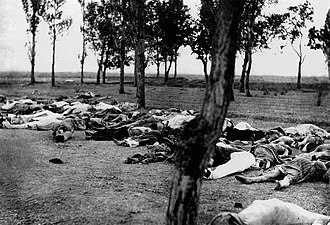
Armenians still living in the Ottoman Empire supported the 1908 revolution of the Committee of Union and Progress, better known as the Young Turks (no, not those Young Turks), who promised to be a bit nicer to ethnic minorities.[25] After coming into power, the Young Turks started plotting the total extermination of Armenians and other minority populations. The new regime subscribed to the arguments of Ziya Gökalp, an influential Turkish sociologist who argued that the Ottoman state needed to promote "Turkification" of its diverse population to render it homogeneous; the regime considered ethnic minorities to be a negative influence.[26] They began by implementing a wide variety of social programs designed to forcibly assimilate minorities, including renaming children and requiring instruction in schools to be conducted only in Turkish.[27]
Then the world war happened. In 1915, huge Russian armies invaded the Ottoman Empire from the Caucasus border, and the Turks were furious to see that many of those soldiers were Armenian volunteer units.[28] At this point, the Young Turks fully decided that the Armenians, and all Christians in the empire, needed to die if the war was to be won.[29]
The Armenian genocide began in 1915 and progressed until about 1918; the Ottoman Empire committed systematic killings, deportations, and forced displacement of the (predominantly Christian) Armenian population, resulting in the deaths of 1 to 1.5 million people.[30] The factuality of the Armenian genocide is denied by the government of Turkey, which argues that it was a religious and ethnic war and that up to a million Islamic Turks and Kurds died during the period at the hands of Armenian militiamen as part of the broader phenomenon of Christian-Muslim violence throughout the Ottoman Empire at the time. However, some Turks have commemorated the genocide and apologized on behalf of the government.[31]
Postwar catastrophes[edit]
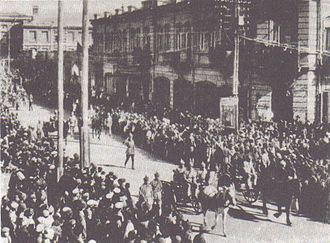
The genocide of Armenians by the Ottoman government completely destroyed what had once been the historical Armenian heartland. Although the eastern regions of Armenia held by Russia weren't safe by any means, they were preferable to the certain death Armenians faced at the hands of the Turks. Thus began an enormous refugee crisis as tens of thousands of Armenians fled from Turkey alongside the retreating Russian armies.[25]
After the Ottoman surrender and the Russian Empire's total collapse, Armenians tried to pick up the pieces and carve themselves out a fragile republic. It didn't go well for them. The First Republic of Armenia![]() was crippled by an unstoppable economic depression. They faced the expansionist Turkish nationalist movement led by Mustafa Kemal Atatürk on one front and the Red Army on another front.[32] Western countries such as France and the UK ignored the situation in favor of shrinking into isolationism.
was crippled by an unstoppable economic depression. They faced the expansionist Turkish nationalist movement led by Mustafa Kemal Atatürk on one front and the Red Army on another front.[32] Western countries such as France and the UK ignored the situation in favor of shrinking into isolationism.
Facing attacks on all fronts, the Armenians finally decided to strike a deal with the lesser of the two evils. In November 1920, the Armenian Republic signed the Treaty of Aleksandropol, agreeing to allow Soviet 'protection' and defining its border with Turkey.[32] The Soviets were immediately brutal towards the Armenians, arresting prominent citizens and murdering them, then unleashing the secret police to uproot any more dissent.[33] This finally provoked the February Uprising in 1922, a popular revolt that bunkered down in the Armenian mountains to cause the Soviets a nice little headache for a few months. Although the uprising was suppressed, the Soviets got the message; up to the 1960s, Moscow only appointed moderate Armenian communist leaders who were allowed to preserve Armenia's cultural heritage.[34]
Soviet rule[edit]

As part of the Transcaucasian Soviet Federative Socialist Republic, Armenia experienced a time of relative peace and stability while receiving food, medicine, and other provisions from Vladimir Lenin's government.[35] Then Joseph Stalin became the Soviet head of state, and everything went to shit again. Stalin happened to be from the neighboring Republic of Georgia, which had fought a brief war with Armenia in 1918.[36] Under Stalin, the Soviet secret police went back to attempting to suppress nationalism and the Armenian Church; Armenia's intellectuals also suffered greatly during the Great Purge.[37] On the other hand, Stalin's reign brought about greater literacy, industry, and infrastructure in a place that had previously known none of those things.[37]
As a result of these improvements, Armenians were ready to take advantage of the new opportunities presented by the less evil policies of Stalin's successors. Armenian nationalism became tolerated once again, and Armenians also benefited from economic growth that brought about urbanization and industrialization.[38] On the bad side, during this era, the corruption that was epidemic within the Soviet Communist Party spread in Armenia, creating a network of bribery and black markets among the elite communist ruling class.[38] Things were good for a time, though, so Armenia remained one of the most loyal Soviet republics…
.jpg)
…until about 1988. By this time, corruption had gotten extremely bad, and the Soviets had proven themselves completely incompetent when it came to caring for Armenia's environment. The Soviets, for instance, used lead pipes to build Yerevan's water infrastructure.[39] They also built a nuclear power plant on prime earthquake territory, which Armenians became very unhappy about after Chernobyl.[40] Then the plant became even more unpopular when it had to be shut down after a 6.8 earthquake struck in 1988 that killed 25,000 people; the plant's shutdown caused rolling blackouts for years because the Soviets hadn't bothered to build any more electrical infrastructure.[41] The nuclear plant lacks a secondary containment system, meaning that any accident would be catastrophic.[42]
At the same time, another issue tested Armenia's loyalty to Moscow. The historically Armenian territory of Nagorno-Karabakh had been placed under the jurisdiction of the Azerbaijan Soviet Republic, and clashes between ethnic Armenians and Azeris escalated rapidly throughout the 1980s.[43] Armenians in Nagorno-Karabakh resented that they had a lower standard of living than those who lived in Armenia. Under the leadership of Mikhail Gorbachev, greater freedom allowed Armenians and Azeris to escalate their increasingly destructive ethnic civil war.
Independence and war[edit]
.jpg)
In 1989, Gorbachev proposed enhanced autonomy for Nagorno-Karabakh within Azerbaijan, which appeased neither side.[44] Azerbaijan began the formalities that year by shutting down roads into Armenia, roads which carried about 90% of Armenia's imports. In August 1989, Karabakh Armenians responded by electing their own National Council, which declared the secession of Karabakh from Azerbaijan and its merger with Armenia.[45]
While that was going on, Armenia started to agonizingly restructure itself into a non-Soviet republic. As had happened elsewhere in the former-Soviet states, this process did not occur smoothly. The transfer of political power was peaceful, but the blockade with Azerbaijan and the collapse of the old political order created a situation in which armed thugs and warlords seized weapons to prepare for the inevitable war.[46] The Armenian government mostly managed to restore order and then declared its intention to secede from the Soviet Union.
Meanwhile, radical Azeris launched multiple pogroms against the Armenian minority in Azerbaijan.[47][48][49] In 1990, the situation had become so bad that Gorbachev ordered a direct intervention. Soviet tanks and troops stormed the Azerbaijani capital of Baku, killing between 130 and 300 people.[50] Soviet troops reportedly shot people at point-blank range, ran over cars with tanks, bombarded hospitals, prevented the medical personnel from helping the wounded, and literally bayoneted the survivors. Although the Soviet Union regained control of Baku, this action lost them the loyalty of Azerbaijan; Armenians had already become disillusioned with the Soviet Union's earlier inaction.
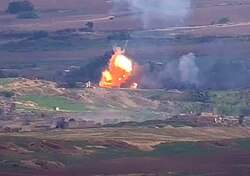
A year later, the Soviet government sent paratroopers into Armenia without notifying its government, which the Armenian authorities interpreted as a declaration of war.[51] Then the 1991 August Coup happened, and most Armenians became convinced that it was time to leave the USSR. In September 1991, over 99 percent of voters approved the republic's commitment to independence.[51] With that process done, Armenia turned its attention toward fighting the war over Nagorno-Karabakh.
During open warfare, Azerbaijan received significant aid from Turkey, Israel, and various Arab states.[52] Despite these advantages, Armenia came out on top due to infighting within Azerbaijan and occupied Nagorno-Karabakh and much of Azerbaijan proper. In 1994, both sides agreed to a cease-fire that froze the war and the issue.[53]
And that's where it stood for decades: a fragile and often breached cease-fire, but no full-scale war and no resolution, either. Hooray? Fighting recently flared up again on 27 September 2020 when Azerbaijan attacked and began the worst bout of fighting yet, leaving hundreds dead and cities on both sides bombed.[54] The result, confirmed on 10 November that year, was a rather lopsided Azeri victory. This military collapse disgraced the once-popular Armenian prime minister Nikol Pashinyan, who is now the target of everything from protests to assassination attempts.[55]
Starting in 2021, Azerbaijan has started invading sovereign Armenian territory, not just the disputed territory of Artsakh. As of September 2022, Azerbaijan illegally occupies over a hundred square kilometers of Armenian soil.[56] The justification for this are bullshit irredentist claims by President Aliyev of Azerbaijan.[57]
Foreign relations[edit]

Post-Soviet Armenia seems to have cordial relations with most countries in the world. The two notable exceptions are its neighbors, Azerbaijan and Turkey, for reasons the rest of this article has hopefully explained.
Azerbaijan and the Nagorno-Karabakh dispute[edit]
Since the outbreak of fighting in 1988, Nagorno-Karabakh has been Armenia's principal foreign policy issue. Between 1988 and 1993, an estimated 10,000 Armenian lives were claimed by this conflict.[58] Skirmishes periodically broke out, which started heating up in the 2020s.[59] As of 2023, Artsakh has been completely dissolved.[60] That's understandable since Armenia supported the secession of the Nagorno-Karabakh Republic[61] It doesn't help that there were atrocities committed by both sides in the early days of the conflict (such as the Khojaly massacre![]() and the Baku pogrom
and the Baku pogrom![]() ), which is a major source of contention between the two countries.[62] Hundreds of thousands of people are still displaced and living in wretched conditions. And if that wasn't enough, there are still a shitload of mines buried all over the place in the disputed territories and along the border, which occasionally blow up and kill people.[61]
), which is a major source of contention between the two countries.[62] Hundreds of thousands of people are still displaced and living in wretched conditions. And if that wasn't enough, there are still a shitload of mines buried all over the place in the disputed territories and along the border, which occasionally blow up and kill people.[61]
Russia[edit]
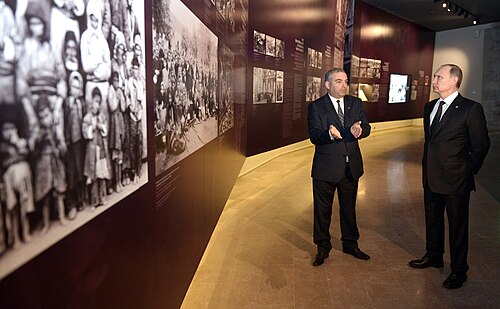
Since independence in 1992, Armenia has had a very close relationship with Russia, despite the country not having a border with it. This is in contrast to its neighbors: Georgia pivots toward the EU and Azerbaijan pivots to Turkey and the Turkosphere. Armenia is a fully paid-up member of the Russian versions of NATO and the EU, the CSTO![]() and Eurasian Economic Union,
and Eurasian Economic Union,![]() which allow Russia to treat the country like a satellite state. Russia has, for example, a major army base, the 102nd Military Base, in the south of the country. In March 2022, Armenia was the sole country other then Russia to oppose expelling Russia from the human rights body, the Council of Europe, over the country's invasion of Ukraine. [63] Many members of Putin's inner circle, including RT's chief Margarita Simonyan and foreign minister Sergei Lavrov, are of Armenian heritage.
which allow Russia to treat the country like a satellite state. Russia has, for example, a major army base, the 102nd Military Base, in the south of the country. In March 2022, Armenia was the sole country other then Russia to oppose expelling Russia from the human rights body, the Council of Europe, over the country's invasion of Ukraine. [63] Many members of Putin's inner circle, including RT's chief Margarita Simonyan and foreign minister Sergei Lavrov, are of Armenian heritage.
However, since Pashinyan became prime minister in 2018 and Putin decided to make Ukraine his personal Poland, Armenia has been moving away from Russia's sphere of influence. Unlike Belarus and Azerbaijan, it has been working with the EU on the EU's European Neighbourhood Policy.[64] Russia's behavior in the area of Nagorno-Karabakh has meant that Armenia has openly said it wouldn't support any of Russia's requests in the CSTO charter. Since the invasion, thousands of Russians have fled to Armenia seeking refuge against the War in Ukraine and importantly said that they would be able to stay.[65] In October 2023, Armenia's parliament voted to ratify the Rome Statute, making the country a party to the International Criminal Court![]() in the Hague, despite Russian opposition [66] (though Armenia denies that this was aimed at Russia and insists this was to hold Azerbaijan accountable for alleged war crimes).[67]
in the Hague, despite Russian opposition [66] (though Armenia denies that this was aimed at Russia and insists this was to hold Azerbaijan accountable for alleged war crimes).[67]
In the first quarter of 2024, relations between Yerevan and Moscow changed significantly between the two countries. This includes Armenia saying it would freeze its behaviour in the CSTO, in effect de facto withdrawing from the organisation, [68] and asking Russian border officials to leave Yerevan airport. [69] Later it did a military and arms agreement with France [70] and the prime minister said his country is looking at formally leaving the CSTO. [71] Relations strained even more with Armenia announcing in March that the country is seeking membership of the European Union. [72] Not surprisingly, this has irked Moscow. [73]
Turkey[edit]
Even though it was one of the world's first countries to recognize Armenia's independence in 1991, Turkey is not particularly fond of Armenia. But why is that? Well, for a few reasons, actually.
First, it's because of the genocide, or specifically its denial. Armenia has repeatedly pressured the international community to recognize and remember the Armenian genocide. Countries like Russia, Brazil, and Canada recognize the event, while the US and Israel refer to it in wishy-washy language to avoid making Turkey mad.[74] Turkey gets pissed off at any country that recognizes the genocide and retaliates diplomatically; it's even angrier with Armenia for constantly raising the issue and allegedly making irredentist territorial claims of certain parts of Turkey.[75][76]
Turkey is also interested in the Nagorno-Karabakh crisis since it is a staunch ally of Azerbaijan. This is because they have a relationship that goes back many centuries. Despite slight religious differences (Turkey is a Sunni Muslim majority country while Azerbaijan has a Shi'a majority, like neighboring Iran), Turks and Azeris have similar cultural, ethnic, and linguistic origins, as both are Turkic.![]() As a result, Turkey has very close relations with Azerbaijan and has pledged to militarily support Azerbaijan for as long as the conflict with Armenia persists.[77]
As a result, Turkey has very close relations with Azerbaijan and has pledged to militarily support Azerbaijan for as long as the conflict with Armenia persists.[77]
Turkey supported Azerbaijan during the 2020 war and even airlifted Syrian mercenaries to serve as cannon fodder for the Azeris.[78]
(In)famous Armenians[edit]
Despite being from a family that is said to have produced an Armenian Apostolic priest in every generation since 301,[79] an Armenian fellow named Rushdoony converted to Calvinism and was educated at the University of Edinburgh. Fleeing the Armenian genocide, he came to the United States in 1916 in the company of his wife and young son. Said young son grew up to be the prominent Dominionist kook, R. J. Rushdoony.
Gallery[edit]
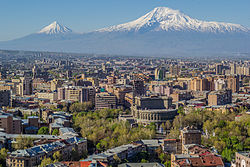
Yerevan, Armenia's capital city.

Armenian manti dumplings.

Khor Virap Monastary.

Armenian children at a chess tournament.
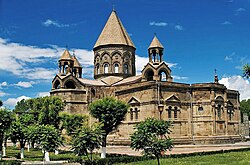
Etchmiadzin Cathedral, possibly the world's oldest Christian church.
Armenian folk musicians.
See also[edit]
- Armenian Genocide denial
References[edit]
- ↑ A small country but a big nation: how genocide shaped the Armenia of today. The Guardian.
- ↑ Garsoïan, Nina (1997). R.G. Hovannisian (ed.). Armenian People from Ancient to Modern Times. 1. Palgrave Macmillan. p. 81.
- ↑ Armenian cave yields what may be world's oldest leather shoe. CNN.
- ↑ 5,900-year-old women's skirt discovered in Armenian cave. News Armenia.
- ↑ Earliest Known Winery Found in Armenian Cave. National Geographic.
- ↑ ThatSee the Wikipedia article on Hayk.
- ↑ Razmik Panossian, The Armenians: From Kings And Priests to Merchants And Commissars, Columbia University Press (2006), ISBN 978-0-231-13926-7, p. 106.
- ↑ See the Wikipedia article on Satrapy of Armenia.
- ↑ See the Wikipedia article on Kingdom of Armenia (antiquity).
- ↑ Armenia: The Ancient Period. Country Studies.
- ↑ The Early Christianization of Armenia. Ancient History Encyclopedia.
- ↑ 12.0 12.1 12.2 Armenia: Early Christianity. Country Studies.
- ↑ See the Wikipedia article on Mesrop Mashtots.
- ↑ See the Wikipedia article on Armenian Kingdom of Cilicia.
- ↑ See the Wikipedia article on Arminiya.
- ↑ 16.0 16.1 16.2 Armenia: The Middle Ages. Country Studies.
- ↑ Herzig, Edmund; Kurkchiyan, Marina (2004). The Armenians: Past and Present in the Making of National Identity. Routledge. p. 47. ISBN 978-1-135-79837-6.
- ↑ 18.0 18.1 See the Wikipedia article on Iranian Armenia (1502–1828).
- ↑ Minahan, James (2010). The complete guide to national symbols and emblems. Santa Barbara, Calif.: Greenwood Press. p. 310. ISBN 978-0-313-34497-8.
- ↑ See the Wikipedia article on Russo-Persian War (1722–1723).
- ↑ Russo-Persian Wars. Encyclopedia.com
- ↑ 10 Most Important Russo-Turkish Wars. Rear Clear History.
- ↑ Armenia: Between Russia and Turkey. Country Studies.
- ↑ 24.0 24.1 24.2 Armenia: National Self-Awareness. Country Studies.
- ↑ 25.0 25.1 The Young Turks. Country Studies.
- ↑ See the Wikipedia article on Ziya Gökalp.
- ↑ Üngör, Uğur Ümit (2008). "Geographies of Nationalism and Violence: Rethinking Young Turk 'Social Engineering'". European Journal of Turkish Studies (7).
- ↑ See the Wikipedia article on Armenian volunteer units.
- ↑ 8 things to know about the mass killings of Armenians 100 years ago. CNN.
- ↑ John Kifner, The New York Times. Armenian Genocide of 1915: An Overview
- ↑ Caleb Lauer, Al Jazeera America. For Turkey, denying an Armenian genocide is a question of identity
- ↑ 32.0 32.1 Armenia: World War I and Its Consequences. Country Studies.
- ↑ See the Wikipedia article on February Uprising.
- ↑ Recalling the Fight for Freedom from Soviet Occupation. Armenian Youth Federation.
- ↑ See the Wikipedia article on Armenian Soviet Socialist Republic.
- ↑ See the Wikipedia article on Georgian–Armenian War.
- ↑ 37.0 37.1 Armenia: The Communist Era. Country Studies.
- ↑ 38.0 38.1 Armenia: Communism after Stalin. Country Studies.
- ↑ The Grim Pollution Picture in the Former Soviet Union. Huffington Post.
- ↑ Is Armenia's Nuclear Plant the World's Most Dangerous? National Geographic.
- ↑ The city in the shadow of an ageing nuclear reactor. BBC.
- ↑ See the Wikipedia article on Armenian Nuclear Power Plant.
- ↑ Armenia: The New Nationalism. Country Studies.
- ↑ Armenia: Nagorno-Karabakh and Independence. Country Studies.
- ↑ Armenia: The Karabakh Crisis Escalates, 1989. Country Studies.
- ↑ Armenia: A New Political Climate. Country Studies.
- ↑ See the Wikipedia article on Sumgait pogrom.
- ↑ See the Wikipedia article on Baku pogrom.
- ↑ See the Wikipedia article on Maraga massacre.
- ↑ Bloody "Black January" became the starting point for independence of Azerbaijan. Jerusalem Post.
- ↑ 51.0 51.1 Armenia: Independence. Country Studies.
- ↑ Melkonian, Markar (2005). My Brother's Road, An American's Fateful Journey to Armenia. New York: I.B. Tauris. ISBN 1-85043-635-5.
- ↑ See the Wikipedia article on Bishkek Protocol.
- ↑ Azerbaijan, Armenia report shelling of cities despite truce. Associated Press.
- ↑ Azerbaijan Celebrates 'Victory,' Armenia In Crisis After Nagorno-Karabakh Deal. Radio Free Europe.
- ↑ "Azerbaijan's casualties in tensions on Armenian border rise to 80 — ministry". tass.com. 17 September 2022. Archived from the original on 18 September 2022. Retrieved 17 September 2022.
- ↑ "What's the future of Azerbaijan's 'ancestral lands' in Armenia?" - EurasiaNet. Written by Joshua Kucera. Published July 16, 2021.
- ↑ Armenia Foreign Relations. Country Studies.
- ↑ Nagorno-Karabakh Conflict. Council on Foreign Relations.
- ↑ https://www.reuters.com/world/asia-pacific/more-than-half-armenians-nagorno-karabakh-have-left-2023-09-28/
- ↑ 61.0 61.1 Nagorno-Karabakh. Global Security.
- ↑ See the Wikipedia article on First Nagorno-Karabakh War.
- ↑ Yerevan Defends Opposing Council Of Europe Vote Against Russia, Asbarez
- ↑ European Commission - European Neighbourhood Policy and Enlargement Negotiations (DG NEAR) - Armenia
- ↑ Russian emigres in Armenia settle in for the long haul, Reuters
- ↑ Armenia ratifies Rome Statute despite Russian warnings, OC Media
- ↑ Armenia formally joins international criminal court in snub to Russia. The Guardian. 31 January 2024.
- ↑ "L'Azerbaïdjan prépare une attaque contre l'Arménie", selon le Premier ministre arménien. France 24
- ↑ Armenia Officially Asks Moscow To Remove Russian Border Troops From Yerevan Airport, Radio Free Europe-Radio Liberty
- ↑ Armenia signs arms contract with France amid boost in military ties, Radio France Internationale
- ↑ Pashinyan Won't Rule Out Armenia's Exit From CSTO, Azatutyun
- ↑ PM calls on Armenians to discuss EU membership, Euractiv
- ↑ Russia Warns Of Response To Armenia’s Tilt To West, Azatutyun
- ↑ Q&A: Armenian genocide dispute. BBC News.
- ↑ Armenian genocide: what victims’ descendants demand from Turkey 106 years later. JAMnews.
- ↑ See the Wikipedia article on Armenia-Turkey relations.
- ↑ Nagorno-Karabakh clash: Turkey backs Azeris 'to the end' against Armenia. BBC.
- ↑ https://www.bbc.com/news/stories-55238803
- ↑ British Centre for Science Education. Rousas Rushdoony
Categories: [Asian countries] [Middle Eastern countries] [European countries] [Christianity] [Government incompetence]
↧ Download as ZWI file | Last modified: 09/06/2025 08:11:20 | 319 views
☰ Source: https://rationalwiki.org/wiki/Armenia | License: CC BY-SA 3.0
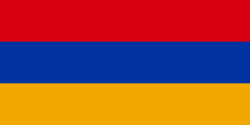

 KSF
KSF